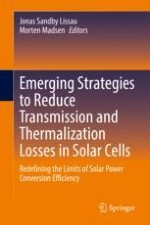2022 | OriginalPaper | Buchkapitel
15. Singlet Fission Solar Cells
verfasst von : Bruno Ehrler
Erschienen in: Emerging Strategies to Reduce Transmission and Thermalization Losses in Solar Cells
Aktivieren Sie unsere intelligente Suche, um passende Fachinhalte oder Patente zu finden.
Wählen Sie Textabschnitte aus um mit Künstlicher Intelligenz passenden Patente zu finden. powered by
Markieren Sie Textabschnitte, um KI-gestützt weitere passende Inhalte zu finden. powered by
